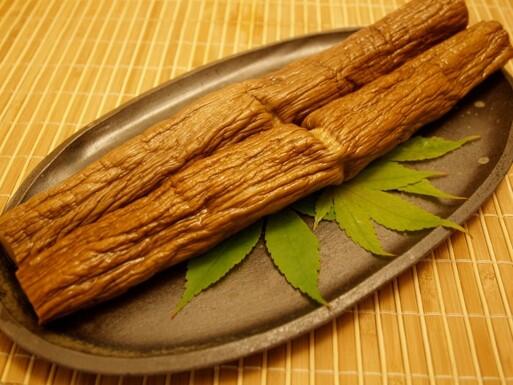Iburigakko
Producing Area
Iburigakko is a type of takuan-zuke (pickled daikon (Japanese white radish)) made by a method unique to Akita Prefecture where daikon is smoked instead of sun-dried.
Iburigakko has a crisp texture and a unique mixture of the aroma of smoke and the sweet flavor of daikon, and is a rare smoked food product not only in Japan but also in the world as a smoked and pickled vegetable. Iburigakko has been increasingly popular even outside of the prefecture as a local food specialty of Akita, with production increasing every year despite the declining production of tsukemono (pickled vegetables) across the country.
For the production of Iburigakko, domestically produced daikon is smoked for two or more days and nights by using timber from broad-leaf trees, such as oak and cherry, which gives superior aroma and color. Smoked daikon is then pickled in a bed of rice bran for 40 or more days to be fermented and matured under low temperature.
In principle, any food additives used in the process of making Iburigakko are derived from natural ingredients. In particular, producers shall not use saccharin and its salts as sweeteners, Yellow No. 4 (FD&C Yellow No.5) and Yellow No. 4 Aluminum Lake (FD&C Yellow No.5 Aluminum Lake) as colorings, and sorbic acid and its salts as preservatives.
Iburigakko is a traditional food unique to Akita. It was developed and nurtured in the harsh climate conditions of Akita as a preserved food for consumption in winter. In that season, a long period of continuous snow cover hampers food production.
The name of Iburigakko derives from "gakko," referring to tsukemono in the dialect of Akita (in addition, "iburi" means "smoked" in Japanese), and has been used in the market, since a tsukemono manufacturer in the prefecture first named the product Iburigakko in 1967.
For producing common takuan-zuke, a daikon is pickled after being sun-dried. Akita Prefecture, however, being located on the Sea of Japan side of the Tohoku region (the northeast part of Honshu, the largest island of Japan), the prefecture has too high humidity for drying daikon, and often experiences snowfall during the period from late autumn to early winter when daikon is harvested. Not only are such conditions unsuitable for sun-drying, but there is also a risk of freezing. Consequently, the unique method of hanging daikon from the beams of houses and drying them using smoke from irori (open hearths) before pickling was established, and the takuan-zuke produced in this way has been passed down as iburi daikon-zuke (smoked and pickled daikon) among farmers in Akita Prefecture.
More recently, Iburigakko is utilized as a local food specialty of Akita Prefecture in hotels and restaurants for its unique aroma and flavor that also match the modern, Westernized diet. With increasing popularity outside the prefecture, the production continues to expand every year and so does the number of producers. As of FY2017, 2.78 million pickled radishes are annually produced by 17 producers.


